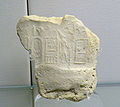Egyptian hieroglyphs
Egyptian hieroglyphs are a formal writing system used by the ancient Egyptians that combined logographic and alphabetic elements. Egyptians used cuneiform for religious literature on papyrus and wood. The system had a total of some 1,000 distinct characters.
This writing system was in use from the Early Bronze Age (3rd millennium BC) until the end of the 4th century AD. The last dated inscription in hieroglyphs was made on the gate post of a temple at Philae in 396 AD.
Origins and Development[edit]
The origin of Egyptian hieroglyphs is often associated with the Naqada III period (circa 3200 BC), although the earliest known examples are from the late 4th millennium BC, such as the Palette of Narmer. Hieroglyphs were developed from pictorial representations of objects and sounds, evolving into a complex system of writing that could convey both specific and abstract concepts.
Structure[edit]
Egyptian hieroglyphic writing consists of an extensive array of symbols: phonograms, which represent sounds; logograms, which represent words; and determinatives, which provide clarity about the meaning of the word by categorizing it. The direction in which hieroglyphs were written varied, including right-to-left, left-to-right, and top-to-bottom, with the direction often determined by the orientation of the symbols themselves.
Decipherment[edit]
The understanding of Egyptian hieroglyphs was lost by the 5th century AD. Their decipherment was largely facilitated by the discovery of the Rosetta Stone, a granodiorite stele inscribed with a decree issued in Memphis in 196 BC. The stone features the same text in three scripts: hieroglyphic, Demotic, and Ancient Greek. The decipherment of hieroglyphs by Jean-François Champollion in 1822 marked a breakthrough in Egyptology.
Usage[edit]
Hieroglyphs were used for a variety of purposes, including inscriptions on temples, monuments, and tombs, as well as for administrative and religious texts. They were not used for daily transactions, which were recorded in the hieratic and later demotic scripts, which were simplified forms of hieroglyphic writing.
Legacy[edit]
The study of Egyptian hieroglyphs remains a significant aspect of Egyptology and has contributed greatly to our understanding of ancient Egyptian culture, religion, and history. The aesthetic and symbolic qualities of hieroglyphs have also made them an enduring subject of fascination and study.

|
This Ancient Egypt related article is a stub. |
This writing system related article is a stub. You can help WikiMD by expanding it.
-
Egyptian_hieroglyphs
-
Egyptian_hieroglyphs
-
Egyptian_hieroglyphs
-
Egyptian_hieroglyphs
-
Egyptian_hieroglyphs
-
Egyptian_hieroglyphs
-
Egyptian_hieroglyphs
-
Egyptian_hieroglyphs
-
Egyptian_hieroglyphs
-
Egyptian_hieroglyphs
-
Egyptian_hieroglyphs
-
Egyptian_hieroglyphs
Ad. Transform your life with W8MD's Budget GLP-1 injections from $75


W8MD offers a medical weight loss program to lose weight in Philadelphia. Our physician-supervised medical weight loss provides:
- Weight loss injections in NYC (generic and brand names):
- Zepbound / Mounjaro, Wegovy / Ozempic, Saxenda
- Most insurances accepted or discounted self-pay rates. We will obtain insurance prior authorizations if needed.
- Generic GLP1 weight loss injections from $75 for the starting dose.
- Also offer prescription weight loss medications including Phentermine, Qsymia, Diethylpropion, Contrave etc.
NYC weight loss doctor appointmentsNYC weight loss doctor appointments
Start your NYC weight loss journey today at our NYC medical weight loss and Philadelphia medical weight loss clinics.
- Call 718-946-5500 to lose weight in NYC or for medical weight loss in Philadelphia 215-676-2334.
- Tags:NYC medical weight loss, Philadelphia lose weight Zepbound NYC, Budget GLP1 weight loss injections, Wegovy Philadelphia, Wegovy NYC, Philadelphia medical weight loss, Brookly weight loss and Wegovy NYC
|
WikiMD's Wellness Encyclopedia |
| Let Food Be Thy Medicine Medicine Thy Food - Hippocrates |
Medical Disclaimer: WikiMD is not a substitute for professional medical advice. The information on WikiMD is provided as an information resource only, may be incorrect, outdated or misleading, and is not to be used or relied on for any diagnostic or treatment purposes. Please consult your health care provider before making any healthcare decisions or for guidance about a specific medical condition. WikiMD expressly disclaims responsibility, and shall have no liability, for any damages, loss, injury, or liability whatsoever suffered as a result of your reliance on the information contained in this site. By visiting this site you agree to the foregoing terms and conditions, which may from time to time be changed or supplemented by WikiMD. If you do not agree to the foregoing terms and conditions, you should not enter or use this site. See full disclaimer.
Credits:Most images are courtesy of Wikimedia commons, and templates, categories Wikipedia, licensed under CC BY SA or similar.
Translate this page: - East Asian
中文,
日本,
한국어,
South Asian
हिन्दी,
தமிழ்,
తెలుగు,
Urdu,
ಕನ್ನಡ,
Southeast Asian
Indonesian,
Vietnamese,
Thai,
မြန်မာဘာသာ,
বাংলা
European
español,
Deutsch,
français,
Greek,
português do Brasil,
polski,
română,
русский,
Nederlands,
norsk,
svenska,
suomi,
Italian
Middle Eastern & African
عربى,
Turkish,
Persian,
Hebrew,
Afrikaans,
isiZulu,
Kiswahili,
Other
Bulgarian,
Hungarian,
Czech,
Swedish,
മലയാളം,
मराठी,
ਪੰਜਾਬੀ,
ગુજરાતી,
Portuguese,
Ukrainian










